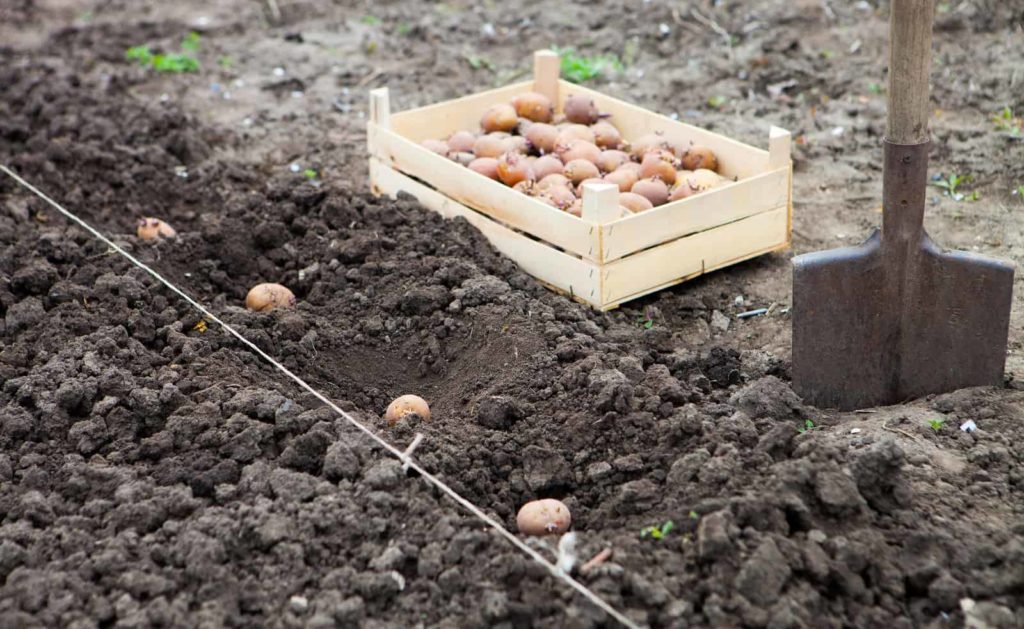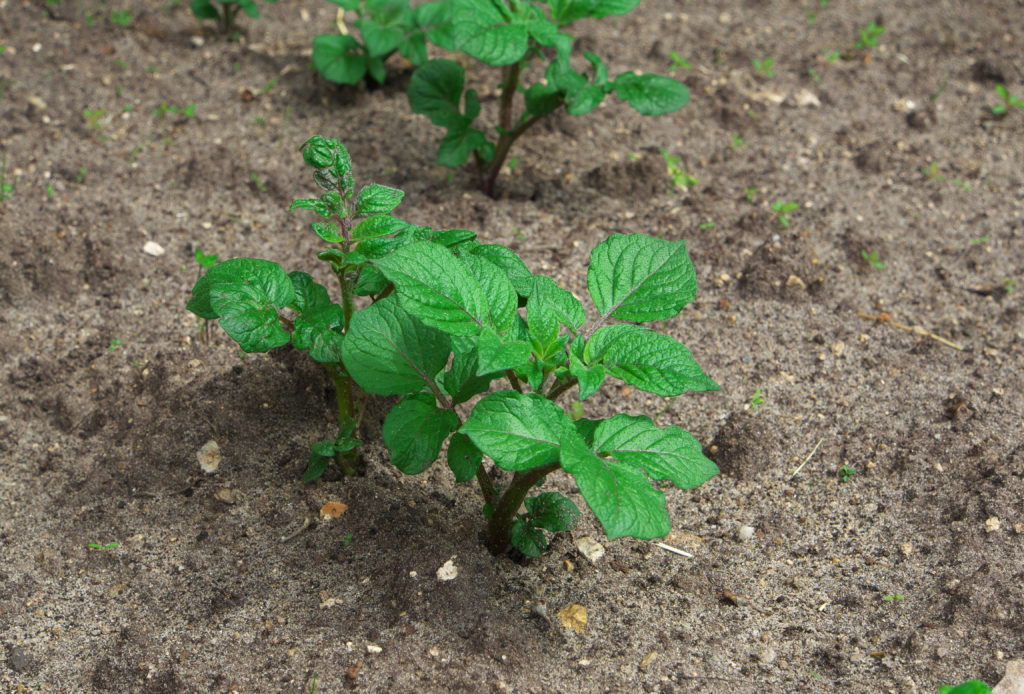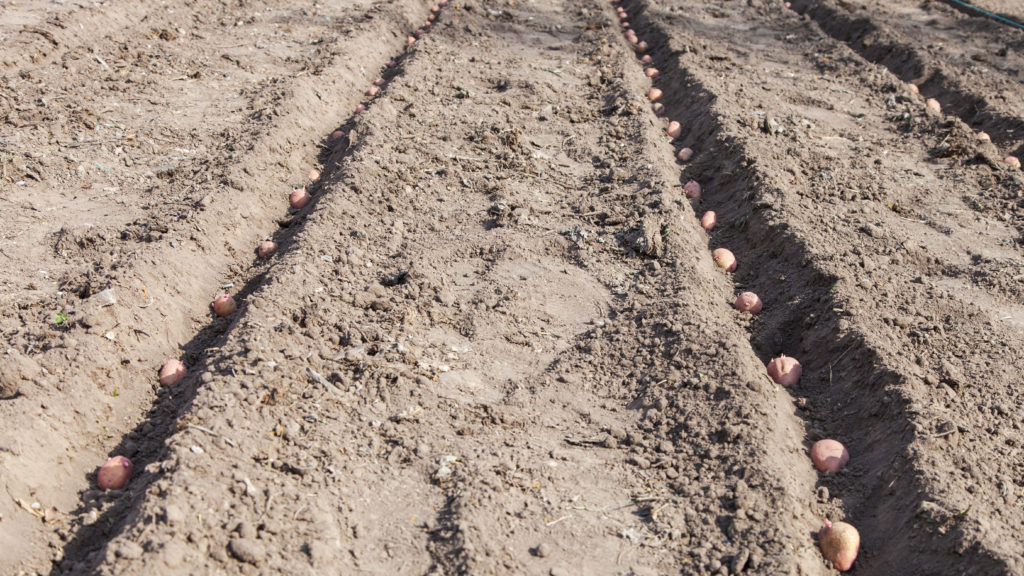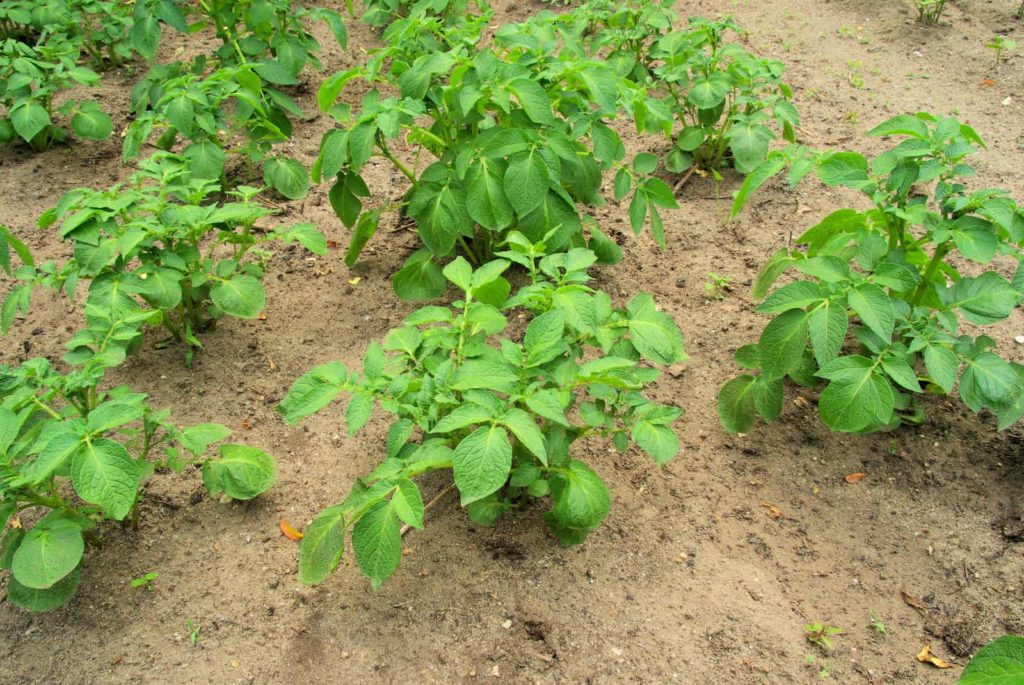Potatoes are grown from other potatoes. Small, whole potatoes are called “seed potatoes”. Plant seed potatoes to grow new potato plants. You can also grow potato plants from cut pieces of larger potatoes. Make sure that you plant seed potatoes or potato pieces that have two or three dormant buds, called “eyes”. Eyes are slightly recessed spots on the surface of a potato.
Plant seed potatoes 2 to 4 weeks before the last frost. Potatoes develop best in the cool weather of spring. The best tuber formation occurs when the daytime temperature is 60° to 65°F (16°-18°C) and night temperatures are about 10 degrees cooler.
Potato Growing Success Products at Amazon:
- 8x4x2FT Galvanized Metal Raised Garden Bed for Vegetables
- Monterey BT Caterpillar Killer
- Harris Diatomaceous Earth With Duster
- Monterey Liqui-Cop Fungicide
- 10-Gallon Potato Grow Bags pack of 4
- 7-Gallon Potato Grow Bags, pack of 4

Potatoes are a cool-weather crop, but the leafy tops can’t tolerate more than a light frost. Plant potatoes so they come to harvest when the weather is cool but not cold. In cold-winter climates, plant seed potatoes in the garden in spring as soon as the soil can be worked—usually about 3 to 6 weeks before the last frost– for harvest in summer. In mild-winter climates, plant potatoes in the fall for a winter or spring harvest. Where winters are mild and summers are hot, potatoes can be planted in late winter or autumn for harvest during cool weather.
Potatoes mature in about 100 days, but you can harvest new potatoes (small tubers) any time they reach usable size, for full-size tubers wait until the foliage dies down around the time of the first frost to harvest. Lift potatoes with a garden fork being careful not to bruise them.
Potatoes will begin to grow as soon as the soil temperature reaches 45°F (7°C). Potatoes very nearly stop growing when the daytime temperatures rise to greater than 80°F (26°C).
Potatoes mature in 45 to 80 days depending on the variety. Time the planting so that tubers come to harvest in cool weather.
Potato planting details
- Sowing depth: 4 to 6 inches (10-15cm)
- Space between plant after thinning: 10-12 inches (25-30cm)
- Days to sprout: 12-16
- Days to harvest: early 80-90; mid-season 90-110; late 110-120
- Storage period: 12-24 weeks
- Seeds for 100-row feet: 15 pounds
- Yield per 100-row feet: 250 pounds
- Suggested Varieties: early—Sable, Fundy, Warba, Irish Cobbler; mid-season—Keswick, Cherokee, Avon, Hunter; late—Kennebec, Netted Gem, Green Mountain.
Potato Growing Success Products at Amazon:
- 10-Gallon Potato Grow Bags pack of 4
- 7-Gallon Potato Grow Bags, pack of 4
- Monterey BT Caterpillar Killer
- Safter Insecticidal Soap & Pyrethrin
- Harris Diatomaceous Earth With Duster
- Monterey Liqui-Cop Fungicide

Potato sowing and planting tips
Potatoes grow best in loose, humus-rich, well-drained soil. Grow potatoes in full sun. Be sure to keep the soil moist when potatoes flower; that’s when tubers develop. As the stems grow, hill up soil around the branches to give tubers room to expand.
Pay attention to the soil pH when growing potatoes. The best pH range for the highest yield is 5.2 to 5.7. A pH above 5.7 will encourage scabs; a pH below 5.2 can reduce the yield.
- Grow potatoes from certified organic, disease-free seed potatoes. Plant small whole-seed potatoes or plant large seed potatoes cut into pieces, each with one to two eyes or growing points, attached to part of the fleshy tuber. (Grocery store potatoes are usually treated to inhibit sprouting so they are not a viable choice for planting.) Before planting, cut pieces should be dried overnight to prevent rotting.
- Potatoes will begin to grow as soon as the soil temperature reaches 45°F (7°C). They can be planted 3 to 2 weeks before the last frost—earlier if protected by a plastic tunnel or cold frame. Planting should be timed so that tubers are harvested before daytime temperatures reach 80°F (26°C) or warmer.
- Sow pieces cut side down in a 4-inch-deep (10 cm) trench in heavy soil or a 6-inch-deep (15 cm) trench in light soil then cover with 2 to 4 inches of soil.
- Space seed potatoes 12 inches (30 cm) apart.
- The optimal soil temperature for growing potatoes is 60-65°F (16-18°C).
- Keep the soil just moist; do not overwater.
- Potatoes prefer a soil pH range of 5.0 to 6.5.
- Grow potatoes in full sun for the best yield.
- When leafy tops are 12 inches (30 cm) tall, “hill” them by drawing soil up around the plants so that just the top few leaves are visible above the soil. Hilling will keep developing tubers from exposure to light which can turn them green. You can hill potatoes more than once as plants grow.
- Commonly when plants flower tubers have begun to form underground, but some potato plants produce tubers without flowering.
- Fertilize potato plants with an organic fertilizer that has a higher phosphorus and potassium content than nitrogen.
- A common potato pest enemy is the Colorado potato beetle.
Container growing potatoes
- Grow potatoes in a container at least 30 inches (76 cm) deep and 20 inches (51 cm) across.
- Place 10 inches (25 cm) of soil at the bottom of the container then place sprouted seed potatoes on top of the soil and cover with 2 inches (5 cm) of soil.
- Using the “hilling” process, allow the plants to grow 6 inches (15 cm) then cover again with 2 to 3 inches of soil.
- Continue this process, allowing the plants to grow about 6 inches before covering half of the leaves with soil again.
Potato planting calendar
Planting for summer harvest:
- 6-8 weeks before the last frost in spring: plant seed potatoes under a plastic tunnel or cold frame.
- 2-3 weeks before the last frost in spring: plant seed potatoes in the open garden; minimum soil temperature is 45°
- Every 4 weeks until 12 weeks before the first frost in fall plant succession crops.
Planting for fall harvest:
- 12-14 weeks before the first frost in fall: plant seed potatoes.

Seed potato planting dates
(These dates are for the Northern Hemisphere)
| Average date of the last frost | Planting dates |
| Jan. 30 | Jan. 1-Feb. 15 |
| Feb. 8 | Jan. 1-Feb. 15 |
| Feb. 18 | Jan. 15-Mar. 1 |
| Feb. 28 | Jan. 15-Mar. 1 |
| Mar. 10 | Feb. 1-Mar. 1 |
| Mar. 20 | Feb. 10-Mar. 15 |
| Mar. 30 | Feb. 20-Mar. 20 |
| Apr. 10 | Mar. 10-Apr. 1 |
| Apr. 20 | Mar. 15-Apr. 10 |
| Apr. 30 | Mar. 20-May 10 |
| May 10 | Apr. 1-June 1 |
| May 20 | Apr. 15-June 15 |
| May 30 | May 1-June 10 |
| June 10 | May 15-June 1 |

Types of potatoes and recommended varieties
There are several types of potatoes. Choose types and varieties to grow based on how you plan to use the potato. Here are several potato types:
- Russet, also called baking potatoes or Idaho potatoes: elliptical shape, 4 to 6 inches long; use for boiling, baking, or deep frying.
- Fingerlings: thumb-sized can be baked, boiled, steamed, fried, and roasted. Varieties include ‘Ruby’, ‘Russian Banana’, and ‘Long White.’
- Yellow: round to slightly oblong with thin, yellowish skins, and buttery yellow flesh; they can be boiled, steamed, mashed, roasted, and grilled. Varieties include ‘Yukon Gold’, ‘Yellow Finn’, and ‘German Butterball.’
- Round white: medium-sized with light tan to freckled brown skin and waxy to creamy textured flesh; they can be boiled, roasted, fried, and mashed. Varieties include ‘Kennebec’, ‘Superior’, and ‘Atlantic.’
- Round red also called boiling potatoes: medium-sized, dense, crisp white flesh; use for boiling, roasting, grilled. Varieties include ‘Norland’ and ‘Pontiac.’
Botanical Name: Solanum tuberosum
Potatoes are a member of the Solanaceae family; other members of this family are tomatoes, eggplants, and peppers.
Potato articles at Harvest to Table:
How to Plant and Grow Potatoes
6 Easy Steps to Grow Organic Potatoes
Grow Potatoes in Pots and Grow Bags: Seven Easy Steps
Seven Ways to Cook and Serve Potatoes
How to Cook New Potatoes with No Recipe
How to Make Seasonal and Flavorful Potato Salad
Yellow Potato Side Dish and Soup
Ham, Potato, and Cheese Gratin
Potato Growing Problems Troubleshooting
Colorado Potato Beetle Organic Pest Control
Garden Planning Books at Amazon:
- Tomato Grower’s Answer Book
- Vegetable Garden Almanac & Planner
- Kitchen Garden Grower’s Guide Vegetable Encyclopedia
- Vegetable Garden Grower’s Guide















